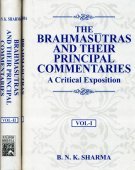Aparoksha, Aparōkṣa, Aparokṣa: 12 definitions
Introduction:
Aparoksha means something in Hinduism, Sanskrit, Marathi, Hindi. If you want to know the exact meaning, history, etymology or English translation of this term then check out the descriptions on this page. Add your comment or reference to a book if you want to contribute to this summary article.
The Sanskrit terms Aparōkṣa and Aparokṣa can be transliterated into English as Aparoksa or Aparoksha, using the IAST transliteration scheme (?).
Alternative spellings of this word include Aparoksh.
Languages of India and abroad
Marathi-English dictionary
Source: DDSA: The Molesworth Marathi and English Dictionaryaparōkṣa (अपरोक्ष).—a (S a, para, akṣi) Not invisible or imperceptible. 2 Present; before the sight or view. 3 (Commonly, but inaccurately.) Absent or away: or as ad or prep In the absence of; behind the back of.
Source: DDSA: The Aryabhusan school dictionary, Marathi-Englishaparōkṣa (अपरोक्ष).—a Not invisible. Present, before the sight or view. (Commonly, but inaccurately.) Absent or away. ad or prep. In the absence of, behind the back of.
Marathi is an Indo-European language having over 70 million native speakers people in (predominantly) Maharashtra India. Marathi, like many other Indo-Aryan languages, evolved from early forms of Prakrit, which itself is a subset of Sanskrit, one of the most ancient languages of the world.
Sanskrit dictionary
Source: DDSA: The practical Sanskrit-English dictionaryAparokṣa (अपरोक्ष).—a.
1) Not invisible, perceptible to the senses, visible.
2) Not distant or remote.
-kṣam adv. In the presence of (with gen.) अपरोक्षात् (aparokṣāt) perceptibly, visibly, manifestly, openly.
Source: Cologne Digital Sanskrit Dictionaries: Edgerton Buddhist Hybrid Sanskrit DictionaryAparokṣa (अपरोक्ष).—(= Sanskrit) in °kṣa-vijñāna Lalitavistara 403.5, 9 (of Rudraka Rāmaputra) and °kṣa-jātīya Mahāvastu iii.322.11, 14 (of Udraka Rāmaputra) or -jātika Mahāvastu iii.415.10, all [bahuvrīhi] adj., of manifest, open understanding (Lalitavistara), or manifest, open (? not obscure? precise meaning not very clear) in nature (Mahāvastu). Tibetan renders Lalitavistara rnam par śes pa (= vijñāna) lkog tu ma gyur pa, (having) not secret intelligence (wrongly Foucaux). Cf. aparakṣa.
Source: Cologne Digital Sanskrit Dictionaries: Benfey Sanskrit-English DictionaryAparokṣa (अपरोक्ष).—I. adj. not imperceptible, [Daśakumāracarita] in
Aparokṣa is a Sanskrit compound consisting of the terms a and parokṣa (परोक्ष).
Source: Cologne Digital Sanskrit Dictionaries: Cappeller Sanskrit-English DictionaryAparokṣa (अपरोक्ष).—[adjective] not beyond the eye or out of sight, witnessed, testified, perceptible, clear; [abstract] aparokṣa++tva [neuter]
— aparokṣam & aparokṣe in the presence of; aparokṣāt clearly.
Source: Cologne Digital Sanskrit Dictionaries: Monier-Williams Sanskrit-English Dictionary1) Aparokṣa (अपरोक्ष):—[=a-parokṣa] mfn. not invisible
2) [v.s. ...] perceptible
Source: Cologne Digital Sanskrit Dictionaries: Goldstücker Sanskrit-English DictionaryAparokṣa (अपरोक्ष):—[tatpurusha compound] m. f. n.
(-kṣaḥ-kṣā-kṣam) 1) Not distant, not remote; e. g. in the Sūtra of Pāṇini Iii. 2. 119. and the Kār. 2. to Iii. 2. 118., where the past which is not remote is opposed to the past which is remote (as treated Iii. 2. 115 ff.).
2) Perceptible, clear; e. g. in the Sāṅkhya Sūtras: yuktito pi na bādhyate diṅgūḍhavadaparokṣādṛte (scil. bandhaḥ or the bondage of the soul; comm. = sākṣātkāraṃ vinā); or nānumeyatvameva kriyāyā nediṣṭhasya tattadvatorevāparokṣapratīteḥ (comm. pratyakṣeṇāpi pratītirasti &c.); aparokṣam also used adverbially.
3) Absolute, not qualified; as epithet of Brahman (neuter) in the Bṛhadāraṇyaka Upan., where the ablative aparokṣāt is used absolutely in the sense of the nomin. aparokṣam viz. yatsākṣādaparokṣādbrahma (Śaṅkara: yadbrāhma sākṣādavyavahitaṃ kenacit . draṣṭuraparokṣādagauṇaṃ na śrotrabrahmādivat .; Anandajnāna: mukhyameva draṣṭuravyavahitasvarūpaṃ brahma . tathā ca draṣṭradhīnasiddhatvābhāvātsvatoparokṣamityarthaḥ . śrotraṃ brahma mano brahmetyādi yathā gauṇaṃ na tathā gauṇam .). E. a neg. and parokṣa.
[Sanskrit to German]
Sanskrit, also spelled संस्कृतम् (saṃskṛtam), is an ancient language of India commonly seen as the grandmother of the Indo-European language family (even English!). Closely allied with Prakrit and Pali, Sanskrit is more exhaustive in both grammar and terms and has the most extensive collection of literature in the world, greatly surpassing its sister-languages Greek and Latin.
Hindi dictionary
Source: DDSA: A practical Hindi-English dictionaryAparokṣa (अपरोक्ष) [Also spelled aparoksh]:—(a) direct; visible, tangible; —[rūpa se] directly, obviously.
...
Kannada-English dictionary
Source: Alar: Kannada-English corpusAparōkṣa (ಅಪರೋಕ್ಷ):—[adjective] not imperceptible by senses; perceivable.
--- OR ---
Aparōkṣa (ಅಪರೋಕ್ಷ):—[noun] the fact or condition of being directly perceived (as by senses) ; direct perception.
Kannada is a Dravidian language (as opposed to the Indo-European language family) mainly spoken in the southwestern region of India.
See also (Relevant definitions)
Starts with: Aparokshacudamani, Aparokshajnani, Aparoksham, Aparokshamatanusutrika, Aparokshanubhava, Aparokshanubhuti, Aparokshanubhutisudharnava, Aparokshanushruti, Aparokshat, Aparokshatva, Aparokshay, Aparokshaya, Aparokshayati, .
Ends with: Atyantaparoksha, Lokaparoksha, Sarvaparoksha.
Full-text: Aparoksham, Apratyaksha, Aparokshat, Aparokshay, Aparokshanubhuti, Aparoksh, Prayojanem, Aparokshaya, Jatika, Paroksha, Aparaksha, Jatiya.
Relevant text
Search found 29 books and stories containing Aparoksha, Aparōkṣa, Aparokṣa, Aparoksa, A-paroksha, A-parokṣa, A-paroksa; (plurals include: Aparokshas, Aparōkṣas, Aparokṣas, Aparoksas, parokshas, parokṣas, paroksas). You can also click to the full overview containing English textual excerpts. Below are direct links for the most relevant articles:
Vivekachudamani (by Shankara)
Mundaka Upanishad (Madhva commentary) (by Srisa Chandra Vasu)
Chapter 5 - Third Mundaka, First Khanda
Chapter 4 - Second Mundaka, Second Khanda
Siddhanta Sangraha of Sri Sailacharya (by E. Sowmya Narayanan)
Chapter 29 - The Discussion about Real Knowledge
Chapter 28 - The Validity of Perception
Chapter 30 - The five divisions of sense-object relationship
Sahitya-kaumudi by Baladeva Vidyabhushana (by Gaurapada Dāsa)
Text 4.26 < [Chapter 4 - First-rate Poetry]
Taittiriya Upanishad Bhashya Vartika (by R. Balasubramanian)
Verse 2.639-640 < [Book 2 - Brahmavallī]
Kena upanishad (Madhva commentary) (by Srisa Chandra Vasu)
Related products

